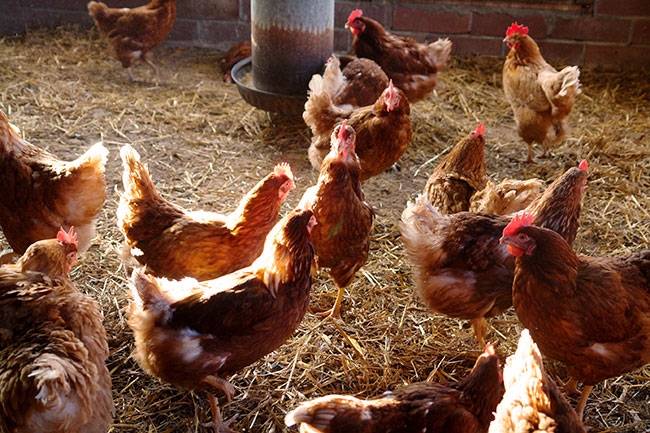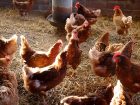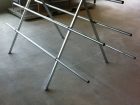
Enrichments offerings for free-run housing
By Treena Hein
Features Equipment Layers Poultry Equipment Production Alternative poultry housing Animal Housing annex Cage free Canada Egg production Livestock Production Phasing Out Conventional Poultry Production ProductionDetails on nests, perches and more.
 Getty Images
Getty ImagesThe updated National Farm Animal Care Council code of practice for laying hens contains many specifications for foraging, perches and nests – enrichments that allow the hens to engage in natural behaviours. These enhancements vary to some degree among housing providers. Here’s what some of them offer and why.
Chore-Time
Milford, Ind.-based Chore-Time now sells Volito cage-free housing systems for laying hens in Canada, having recently acquired the Netherlands-based firm. Volito nests are made from film-faced plywood, which product manager Frank Luttels says is more durable and more resistant to moisture, ammonia and disinfectants than plastic. “Wood is also an excellent noise dampener and provides a quiet nesting place,” Luttels explains. “In terms of curtains, our nests have one opening at the front. We did testing and more openings distract the birds and they don’t feel comfortable.”
Every section of the nest has two red flaps and an entrance opening in the middle. If the hens are startled, they can leave the nest over the whole width of the nest section.
Luttels says a red curtain colour is used because the birds seem to show good acceptance to it and it provides some darkness. The nests can be washed wet or dry.
Jansen
Meller Poultry Equipment sells Netherlands-based Jansen layer housing systems. Similar to Volito, Jansen nests are made from a plastic-coated plywood. “Wood is a warm material and creates a safe feeling for the bird,” Meller president Chris Bill says. “There are two red curtains per 120 cm opening of each nest.”
He notes there is very little maintenance to the nest itself other than cleaning of the AstroTurf nest mat between the flock cycles and also cleaning of the nesting equipment itself. Each nest has a false back wall that is used to close the nest, Bill notes, preventing hens from entering during the night. This helps keep the nest clean.
Salmet
Ontario Equipment Sales (OES) distributes Germany-based Salmet poultry housing systems. In free-run barn systems, Salmet nests are made from galvanized metal sheets to provide good hygiene and also prevent heat accumulation. The bottom is covered with AstroTurf. OES general manager Larissa Leitch says the steel is very unattractive for red-mites compared to wood.
The nests are available in two different depths, with two curtains of yellow tarpaulin. “Between the curtains there is a gap to provide easy access for the birds to the nest whilst allowing for air exchange,” Leitch says. The tarpaulin provides a dark and private nest with what she calls a “very high” acceptance rate. The nest is closed automatically at night by folding up the floor.
Foraging areas, perches and ramps
The foraging or scratch areas offered by all companies are normally concrete with shavings or other materials. Leitch notes that in Salmet’s cage-free layer housing system, the complete floor area underneath the system is accessible and can be used with bedding material for foraging and dust bathing.
In terms of perches, those Chore-Time offers are made of metal because Luttels says it’s very durable. The design is a round tube-like one, but the company is also testing an oval perch shape, as some scientists are finding this is a better fit for the hens’ feet.
“We also feel strongly that perches should be available in pullet rearing,” Luttels says. “We like to have 15 cm of perch per bird, from week 17, over the slatted areas. When they perch in the evening, they are nicely spread out in the house and you can get good ventilation at that time, and you prevent the birds from smothering on the slats. They can all sleep on a perch if they want.”
Perches are available from Meller in a 25 to 30 mm diameter galvanised tubing material or in a PVC plastic mushroom shape. “Cleaning is minimal,” Bill explains, “as the birds wear off any dirt and dust.” Salmet uses galvanized steel perches in a round shape or a unique five-corner shape. The latter, Leitch says, offers the benefits of a square perch with a big surface that birds can walk on, but that also allows birds to perch comfortably with a shape that supports their feet. Manure is easily removed from the top surface due to the sloped design.
In terms of ramps, Bill says usually none are required in a free-run barn, as the birds at this age can easily jump or fly to feed in the slatted floor area. No ramps are usually provided with Chore-Time systems if the height of the slatted area is less than 50 cm, but Luttels says they are definitely provided if it’s 50 cm or more for brown birds.
Salmet systems for pullets have ramps but systems for layers usually do not. “The distances are close and offer approach elements that birds can easily use to change from one to another level,” Leitch says. However, if customers want ramps in their free-run layer barns, Salmet can provide them.
Summarized specifications for foraging areas, perches and nests in the new code
All new enriched layer cages must have a minimum of 31 cm2 of flooring space for foraging per 25 birds. For single-tier free-run systems, at least 15 per cent of the usable space must be litter, and hens must be provided with at least one foraging site for each 1,500 (e.g., bales of hay or straw, insoluble grit or oat hulls, or other material that provides foraging opportunities). If multiple sites are provided, they must be evenly distributed. In multi-tier systems, at least 33 per cent of the usable space must be litter, except birds up to 24 weeks of age may have a minimum of 15 per cent litter of the useable space.
For older housing systems, the code’s transitional requirements state that previously built enriched cages must have at least 24.8 cm2 per 25 birds in flooring surface for foraging. For single-tier barns in a free-run system that is fully slatted or where less than 15 per cent of useable space is litter, a solid surface area of at least 1.5 m2 for litter or substrate for dust bathing must be provided for each 1,000 hens and at least one foraging site for each 1,500 hens (e.g., bales of hay or straw, insoluble grit or oat hulls or other material). In multi-tier systems, at least 33 per cent of the usable space must be litter, except up to 24 weeks of age it may be reduced to a minimum of 15 per cent.
In terms of perches, for non-cage systems installed prior to April 1, 2017 or in new systems, each hen must be provided with a minimum of 7.6 linear cm of purpose-designed, elevated perch space, positioned to minimize fecal fouling and made of materials that are easily cleaned and do not harbour mites, designed to minimize injury to hens. Various placement positions are also specified.
Both single bird nests and communal nests can be provided. For flocks placed after April 1, 2017 for furnished cages, each hen must be provided with nest space area of a minimum of 40.6 cm2. The nest space must be enclosed on at least three sides to provide privacy and shading.
Where nest curtains are used, they must extend close to the floor, and various positioning requirements are also specified. For flocks placed after January 1, 2020 in non-cage systems installed prior to April 1, 2017, each hen must be provided with a minimum nest space area of 83.2 cm2 per 120 hens. In enriched cages, each hen must be provided with a minimum nest space area of 65 cm2.
Print this page

